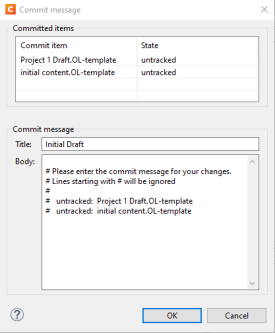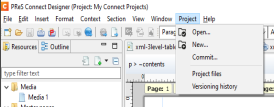Versioned projects
When you create a versioned project, all changes to the project are recorded and stored in the project history. You can use the version history to review changes made to the project, and even revert to a previous version if something goes wrong.
As you work on your project files, you can commit files in the project at any time. When you commit files in the project, a snapshot of the project is saved as a version, along with your name, your commit message, and the date. The status of each file - whether it was added, modified, etc. - is recorded as well.
OL Connect uses Git integration to maintain the history of a project in a local repository. Projects can be created and committed from within the Designer and the DataMapper.
Creating versioned projects
Versioned projects are created from the Project menu at the top of the screen.
To create a new project:
-
Select Project > New from the menu at the top of the screen.
The first time you open or create a new project you may be prompted to enter your name and email. This information is used to identify changes in the project history.
Via the menu: Window > Preferences > Versioning, you can enter or change your name and email at any time. -
Each versioned project needs to be stored in its own folder. Select the folder in which to store the project. The folder name will actually become the name of the project.
The software suggests to store all projects in the Connect folder that is located in the Documents folder, with each project having its own folder under Documents/Connect.If the folder doesn't exist yet, right-click in the right part of the dialog, where the existing folders are listed, and select New. Type the name of the folder that you wish to create and click OK.If you select an existing folder, be aware that any files that exist in the project folder will automatically become part of the project. -
Now you can open an existing template or data mapping configuration (File > Open) or create a new one (File > New).
-
As soon as you save a file in the project folder, it automatically becomes part of the project.
Add a Workflow configuration to a versioned project, simply by saving it in the project folder. -
To record this version in the repository, select Project > Commit. This records the project files as a new version in the repository. Remember to save any changes before you commit.

-
Enter information to describe the changes, then select OK. Describing the changes is important, as it will allow you, later, to readily identify each version as you browse through the project history.

Once created or opened, a versioned project remains open until the application is closed. This means that the software will open the project folder every time you want to open or save a file.
Viewing project history
The project history contains the records for all of the changes made to each resource in the project. When you commit a project, a snapshot of the project resources is stored as a version. You can review the versions to see what changes were made, who made them, and when they were made.
To see the history of the project:
-
With the project open in Designer, select Project > Versioning history from the menu bar.
-
The history displays in the Versioning History tab.
You can select a version from the list to display more information about the changes made in that version.
To restore a previous version, select the version, then select the restore icon. The project is reset to the state it was in when that version was committed.

Viewing project content
Select the Project files option from the Project menu to display the list of resources in the project.

|
The files comprising a Project display in the Project Files panel.
